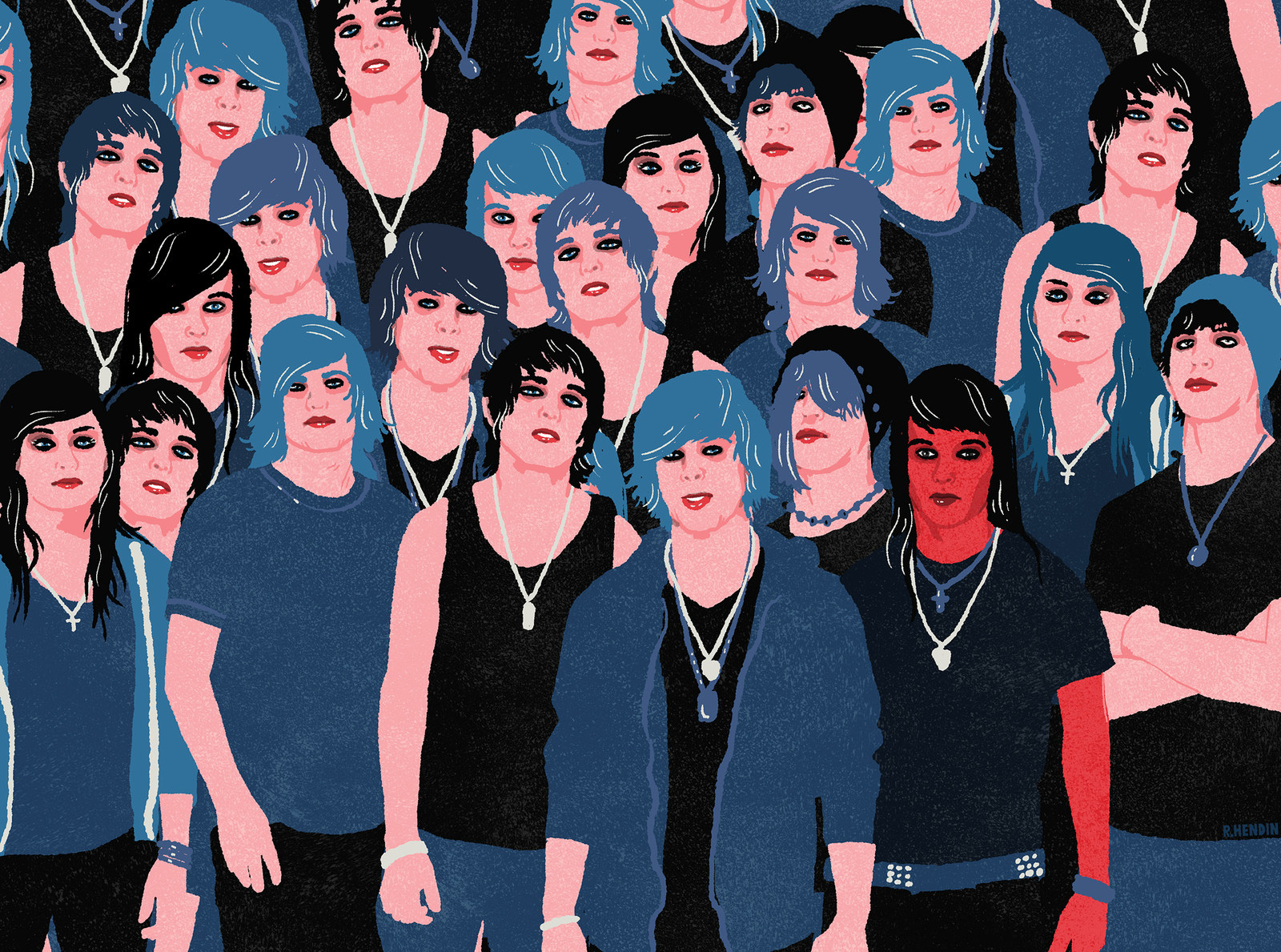I got a really bad emo haircut in 2007: shoulder length, with choppy layers somewhere around my ears. It was a style inspired by a girl in a Punkyfish Clothing ad, and it seemed like the perfect fit for me, considering my teenage interests revolved largely around listening to My Chemical Romance out loud on my phone while hanging out with fellow emos at my local town centre. But it was an ill-judged decision, and I’d failed to factor in the fact that as an Indian girl, I had a lot of thick hair that meant my new layers stuck up comically. I looked, as one friend put it, like a mushroom. And I could tell people, namely my parents, were disappointed with my decision. It was painfully visible on their faces. My hair, once the cause of my “Curly Sue” nickname, and later long and straight and down to my backside, had been chopped at and chopped at as soon as I was old enough to go to to the hairdressers myself, and it had culminated in this.
I felt like a visitor or an onlooker in a world that wasn’t mine to belong to.
The kind of teenager I dreamed of being – all angst and facial piercings and door slamming and dyeing your hair and planning tattoos and being your most alternative self – was intensely important to me, yet incredibly alien. I was the only Asian person in the friendship group I had outside of school, and I was convinced everything would be so much easier if I was white. It’s a teenage thing to think your family is uncool, but because my family was so intrinsically rooted in a series of strict rules, traditions, and expectations, where small rebellions would appear gigantic and the breezy “I’m off out, see you later” my friends said to their parents was so unfamiliar, I was keen to shake myself free of it.
But of course no matter how much I involved myself in what was, at the time, a predominantly white subculture, I felt like a visitor or an onlooker in a world that wasn’t mine to belong to. If I went to a concert, I stood out tremendously, and during those emo gatherings at the park or town centre I was the only brown face.
In my day-to-day life, I knew being a “coconut” didn’t pale my skin or make my features more Eurocentric like I wanted them to be. It didn’t quell any fear that someone would call me a Paki, or that someone would find me out for being an imposter.

By the time I was a fresher at university, my half-a-decade-long affair with being more alternative fizzled out and, bar my thick eyeliner and Doc Martens, I was more of a blank slate than I had been in a long, long time. Yet, like my hair, I continued to chop away at my culture, ignoring being brown in the hopes that maybe nobody would notice I was.
I was studying journalism, and all the best career advice came down to one, terrifying fact: It’s who you know rather than what you know. And I didn’t know anybody. So I took to following “media people” on Twitter – journalists I enjoyed reading, writers at places I wanted to work for – in the hopes I’d be brave enough to start a conversation with any of them and start on the path of upward mobility.
The new internet world I had decided to immerse myself in was a drastic leap from pale teens rating each other on VampireFreaks, but make no mistake about it, it was still predominantly white. But when the first woman who reminded me of myself appeared on my Twitter timeline, it opened up a whole new world for me. She was Indian, like me, with thick dark hair and dark eyebrows. She had an interesting job, and funny, smart tweets. She was a feminist. She talked about dating and sex and made sharp jokes that I half understood but wanted to fully understand. When she retweeted other funny, smart Asian women, I followed them too, until my “who to follow” on Twitter was filled with women whose experiences mirrored mine more than many people I’d come across online before.

In Hindi, didi means older sister. And in the months and years that followed, I found a whole host of new didis online.
I followed them on Instagram; I saw hashtags and bindis and saris and tikki. I saw Twitter handles that referenced food like samosas and pakoras. I followed the Canadian-Pakistani artist Maria Qamar, who joked about Fair and Lovely cream, the same cream I’d grown up seeing when I went to shops in Southall.
In Hindi, didi means older sister. And in the months and years that followed, I found a whole host of new didis online.
I uploaded my photo after a Twitter user encouraged her followers to share selfies, and got a response saying “beautiful! X” from a fellow Indian woman on the other side of the world, and I felt connected in a way I’d never managed in real life. I realised that there would be a generation of young women who would grow up and see a positive view of their race.
Last summer, when “Bitch Better Have My Money” came out, everyone, including me, wanted to know about Sanam, the Indian woman in the video. When I went on her page and saw her wearing a tikki, with mehendi on her hands and a nose chain, looking beautiful but not Eurocentric, it reinforced what I was already learning: that all the wonderful qualities I desired – to be funny, to have a life that’s full and exciting – were not mutually exclusive with being Indian. As an Asian woman, brilliance, beauty, and brownness can and do overlap.
It took all of a few clicks and a few follows to be opened up to a whole new world of South Asian women online, these women who were encouraging me to like my own race, even if doing so from afar and inadvertently.
They were there in the #ReclaimTheBindi hashtags, with women tweeting their selfies and seeing a spectrum of other girls with brown skin and dark hair and dark eyes, all of them beautiful and making a statement about their culture and their heritage – the culture and heritage that I’d strongly denied for a good few years. I had been embarrassed of the connotations I had put upon myself: of submissive women, of being hairy, of haldi fingers.
Just a few months ago, I saw #CurryScentedBitch, and watched women who were around my age and even younger posting pictures of what a “curry-scented bitch” could be. I remembered that to smell of curry was a constant fear whenever food was being cooked, as if it would lend legitimacy to people’s prejudices. The desperate worrying about the smell of thourka in my hair. The fear of haldi under my fingernails if I had eaten with my hands. But as I scrolled through that hashtag, the images changed what those words could mean. Suddenly it meant a beautiful brown girl. It meant thick eyebrows like mine and striking poses with hennaed hands. Where even a few years ago the three words might have reduced me to tears if someone said them, that hashtag said “Yes, so what?”

I feel I owe these women of the internet a lot. My brown skin came to be something I felt confident about. For the first time a few years ago, I wore a bindi to a family wedding. Instead of feeling bored and wanting to rush going suit shopping for family events, I relished in going to Wembley with my naniji and casting my eye over kameezes and saris and lehengas, feeling the weight of the dresses, experimenting with how I would want to wear my chunni. I went out and bought the coconut oil that I used to hate as a child, and at wedding parties I made sure to get mehndi done. A family trip to Glasgow a few months ago saw me, for the first time in my adult life, say yes to a cup of chai instead of asking for “English tea”.
Now when I do my makeup for work in the morning, my eyeliner style isn’t taken from YouTube makeup tutorials. Instead, it’s inspired by the thick kohl lining of old-school Bollywood films I’ve learned about through GIFs. When I write posts about being Indian and I read positive comments, or get an email about someone reading my desi posts with their mum, I like to imagine that one day I could be someone’s internet didi, because the women who have become mine over the years have given me an education in being desi that I never knew I needed.
CORRECTION
“Didi” is the Hindi word for “sister”. An earlier version of this article misstated that it was Punjabi.
